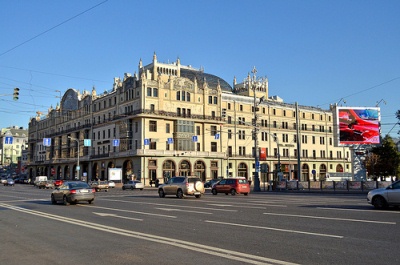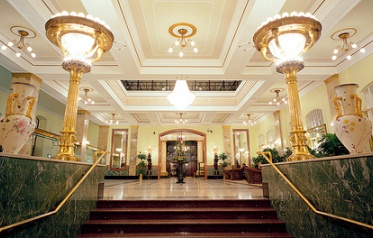

Tetralnyy prospekt 1/4
Tel. (499) 501 7800
Subway: Teatralnaya

The Metropol hotel is a historic hotel in the center of Moscow,
built in 1899-1907 in the art Nouveau style. It is noteworthy that
this is the largest preserved hotel in Moscow, built before the 1917
revolution. This beautiful building is the product of a unique
collaboration between architects William Walcott, Lev Kekushev,
Vladimir Shukhov and artists Mikhail Vrubel, Alexander Golovin, and
Nikolai Andreev.
In 1898, Savva Mamontov and Petersburg
Insurance bought up most of the land around the former Chelyshev
hotel. Mamontov, a Manager and sponsor of a private Opera house,
started to transform the square into a large cultural center built
around the Opera hall. In 1898, a professional jury of an open
competition chose the work of Lev Kekushev, however, Mamontov
intervened and appointed a new English architect, William Walcott,
who proposed an improved project in the art Nouveau style.
Subsequently, Mamontov hired Kekushev as a construction Manager.
Soon after, Savva Mamontov was jailed for fraud, and the project was
taken over by Petersburg insurance, dropping the original plans to
the Opera hall.
In 1901, the top facing burned down and had
to be rebuilt from scratch in reinforced concrete. Kekushev and
walcot hired a constellation of first-year artists, including
Mikhail Vrubel to create the Princess of Dreams mosaic panel,
Alexander Golovin to create a small ceramic panel, and sculptor
Nikolai Andreev to finish the plaster friezes. The Metropol hotel
was completed in 1907. However, it is quite far from the original
walcot design.
In 1918, the hotel was nationalized by the
Bolshevik administration, and the hotel was renamed the Second house
of Soviets. The first house of Soviets was the national hotel. It
housed the living quarters and offices of the growing Soviet
bureaucracy. It was eventually converted to its original hotel
function in the 1930s and underwent a major restoration in 1986-1991
by Finnish companies as part of bilateral trade between the USSR and
Finland. Today, the "Metropol" has 365 rooms, each of which has a
special shape or decoration.
Architectural and artistic features
"Metropol
"is considered to be one of the most striking historical and
architectural monuments of art Nouveau in Moscow. A whole galaxy of
famous and talented architects and artists worked on the creation of
the hotel complex. In addition to William Valkot, Lev Kekushev and
Nikolai Shevyakov, architects P. p. Visnevsky, S. S. Shutsman, V. V.
Voeikov, S. P. Galenzovsky, V. I. Rubanov, M. M. Peretyatkovich, I.
A. German, P. Vulsky, A. Erichson, V. Vesnin, I. Zholtovsky and
(presumably) F. Shechtel participated in the interior design. Murals
and elements of the interior decor were made according to the
sketches of V. Vasnetsov and K. Korovin. Unlike the facades, which
are designed in strict stylistic unity, the interior decoration is
characterized by polystylism: there are interiors in the
pseudo-Russian style, and in the spirit of Neoclassicism.
The
architectural appearance of the "Metropol" is characterized by
strict lines. Elements of pseudo-Gothic (turrets, pinacles) can be
seen through the techniques typical of modernity. The ground floor,
faced with red granite and solved in the form of an arcade,
contrasts with the plastered smooth upper floors, giving the massive
structure an airiness. To visually facilitate the extended facades,
a carefully designed division is used both vertically — with
numerous protrusions, including risalites and Bay Windows, and
horizontally — with an openwork ribbon of balcony grating covering
the entire Central facade. The architect M. M. Peretyatkovich
participated in the decorative finishing of the hotel facades and in
the creation of the drawing of the balcony grating.
According
to Savva Mamontov, when creating the hotel, special attention should
have been paid to the artistic design of the building. As a
passionate promoter of the work of his artist friends, Mamontov
wanted to use the facades of a building in the center of Moscow to
perpetuate the works of a new direction in art. Not least of all,
this circumstance influenced the preference of the Valkot project
over others — it was more adapted for artistic additions. It is also
important that Mamontov's favorite brainchild was the Abramtsevo
ceramic workshop: panels for the "Metropol"were made here. Its
facades are decorated with majolica panels, the most famous of which
is the Princess of Dreams, based on a painting by Mikhail Vrubel; it
occupies a Central place on the main facade of the hotel. Several
other majolica panels were made based on sketches by Alexander
Golovin and Sergey Chekhonin — "Thirst", "Worship of the deity",
"Worship of nature", "Life", "Naiad bathing", "worship of
antiquity"and " Noon". The sculptural frieze "Seasons" encircling
the building was made by Nikolai Andreev.
The hotel
"Metropol" was perceived by its contemporaries as an embodied
Manifesto of new art, largely due to its rich, unusual and refined
decoration.
"Princess Of Dreams»
Panels Vrubel "Princess
Dreams" called the most famous murals of Moscow. It is based on the
story of the drama in the poems of Edmond Rostand La Princesse
lointaine, in the Russian translation by T. L. Shchepkina-Kupernik
called "Princess of Dreams". One of the actors in the play is the
Troubadour Jofre Rudel, whose legend of feeling for a Lady and the
motives of" distant love " of his songs formed the basis of the
plot. The play premiered on the Russian stage in January 1896 in
Saint Petersburg. A romantic story about the sublime desire for love
and perfect beauty, the contemplation of which is achieved at the
cost of death, was a resounding success with the public. There was a
waltz "Princess of Dreams", and even perfume and chocolate with this
name.
In the same year, 1896, S. Yu. Witte ordered Mikhail
Vrubel two paintings for the upcoming Nizhny Novgorod art and
industrial exhibition. One of them Vrubel performed on the plot of
the play rostana, the second - "Mikula Selyaninovich" - on the epic
story. However, the inspection of the panels and sketches caused
great displeasure among the members of the Imperial Academy of arts,
who did not recommend that Vrubel's works be displayed at the
exhibition. Then Savva Mamontov decided to demonstrate them in a
separate pavilion, built on his own initiative. But this idea turned
out to be a failure: despite the favorable assessment of critics,
the public reacted to the works of Vrubel unusually hostile.
When developing the project of the hotel "Metropol", Mamontov had
the idea to repeat the "Princess of Dreams" in ceramics and thereby
put it on public display forever. Since then, the creation of
Vrubel, depicting a dying young knight and a Princess bending over
him, is available to every passer-by. The painting panel, which was
shown at the Nizhny Novgorod exhibition, is now on display in the
Vrubel hall in the Tretyakov gallery.
Hall of the restaurant
" Metropol»
In the design of the lobby of the restaurant
participated painter F. Oborsky, sculptors V. L. Gladkov and V. A.
Kozlov. Abramtsevskaya facing tiles are used in the decoration of
the room.
Big hall
In 1903-1905, after a fire that
occurred two years earlier, the restaurant hall was re-designed in
the forms of modern French-Belgian orientation by the architect S.
p. Galenzovsky. The ceiling of the hall was designed by engineer V.
G. Shukhov by specialists of the Moscow branch of Artur Koppel JSC.
Sketches for the ceiling paintings were prepared by artists S. V.
Chekhov and T. A. Lugovskaya, and tapestry sketches by P. V.
Kuznetsov. In 1910, the design of the large hall of the restaurant
was partially changed by the architect A. E. Erichson.
Small
hall
The decor is based on V. Valkot's sketches (presumably) made
by Moscow masters of M. D. Kutyrin's factory. Painting by the artist
F. Oborsky.